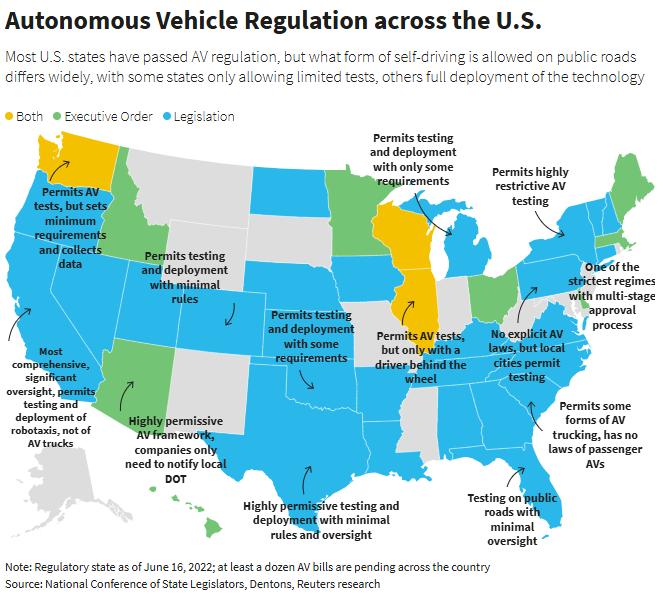Imagine cruising down the highway in a fully autonomous vehicle, your hands free to sip coffee or catch up on work while your car navigates the roads seamlessly. It’s the future that tech companies and automakers have been promising for years, but as we approach the tail end of 2024, that future feels increasingly complicated. The issue isn’t the technology—autonomous vehicles are advancing rapidly—it’s the laws. With each state setting its own regulations for self-driving cars, navigating the legal landscape is as complex as designing the vehicles themselves.
Autonomous vehicles (AVs) are no longer a futuristic concept. Companies like Tesla, Waymo, and Cruise are deploying fleets across the country, testing the limits of automation. Yet, unlike conventional cars, which operate under broadly uniform federal regulations, AVs are governed by a patchwork of state laws that vary significantly. This fragmented approach creates headaches for manufacturers trying to build compliant vehicles and leaves drivers scratching their heads about where they can actually use their cars’ features.
The crux of the problem is the lack of a cohesive federal framework for autonomous vehicles. The National Highway Traffic Safety Administration (NHTSA) has issued voluntary guidelines and safety assessments but stopped short of implementing binding regulations. This hands-off approach has left states to fill the gap, leading to wildly different rules depending on where you live or drive. For instance, Arizona is one of the most permissive states, welcoming autonomous vehicle testing with minimal restrictions. Florida has similarly embraced the technology, allowing fully driverless vehicles to operate on public roads. Contrast this with New York, where AV testing requires a human driver to remain behind the wheel, significantly limiting deployment opportunities.

For manufacturers, this regulatory chaos adds layers of complexity and cost. Designing an autonomous vehicle isn’t just about perfecting algorithms and sensors—it’s also about ensuring compliance with a labyrinth of laws. Imagine building a car that’s legal to operate in Arizona but requires significant modifications to meet New York’s stricter standards. These challenges not only increase development costs but also slow the rollout of autonomous technology across the country. For smaller startups entering the AV space, these barriers can be insurmountable, stifling innovation in an industry poised for explosive growth.
Drivers, too, are feeling the impact of inconsistent regulations. Autonomous vehicles promise to revolutionize personal mobility by making driving safer, more efficient, and more convenient. But varying state laws can strip these vehicles of their functionality. Take a Tesla Model X with Full Self-Driving (FSD) capability. In one state, it might operate as intended, navigating city streets and highways with minimal human input. Drive it across state lines, and suddenly those features may become illegal to use, reducing a cutting-edge vehicle to an ordinary one. For consumers who have invested heavily in these technologies, this lack of consistency is frustrating, to say the least.
The stakes are even higher when considering public safety. Autonomous vehicles have the potential to dramatically reduce traffic fatalities, which claimed more than 42,000 lives in the United States in 2022, according to NHTSA data. Studies suggest that AVs, with their ability to eliminate human error, could prevent a significant portion of these deaths. However, inconsistent state regulations make it difficult to test and deploy these vehicles at the scale necessary to realize their safety benefits. For every state that encourages AV adoption, there’s another that restricts it, delaying the technology’s life-saving potential.
Environmental benefits are also at risk. Autonomous vehicles are seen as a cornerstone of sustainable transportation, particularly when paired with electric powertrains. By optimizing routes and reducing traffic congestion, AVs can significantly lower greenhouse gas emissions. A study by the International Transport Forum found that widespread adoption of AVs could cut CO2 emissions by up to 37% in urban areas. However, without consistent policies to encourage their adoption, these benefits remain theoretical. For an audience that values sustainability and innovation, this is a missed opportunity.
So, what’s the solution? Many industry experts argue that the federal government needs to step in and establish baseline regulations for autonomous vehicles. Such a framework would provide clarity for manufacturers and ensure that consumers can use their AVs seamlessly across state lines. At the same time, states could retain the ability to tailor certain aspects of the rules to address their unique needs. This dual approach could strike a balance between standardization and flexibility, fostering innovation while ensuring safety.
Achieving this balance won’t be easy. Regulators must address a host of complex issues, from cybersecurity to liability in accidents involving autonomous vehicles. Public perception is another hurdle. While a 2024 Pew Research Center survey found that 56% of Americans are optimistic about the future of AVs, concerns about safety and reliability remain high. Effective regulation could go a long way toward addressing these concerns, building public trust in the technology.
The autonomous vehicle industry stands at a crossroads. With the right policies, the U.S. could lead the world in self-driving technology, reaping its safety, environmental, and economic benefits. Without them, we risk falling behind, leaving drivers and manufacturers to navigate a fractured legal landscape that serves no one well. For now, the dream of taking your AV anywhere, anytime, remains just that—a dream waiting for the laws to catch up with the technology.
Continue your exploration of EV policy by reading “The Ultimate Guide to EV Tax Credits in the U.S.” and “The Global EV Race: Which Countries Are Leading in Green Policies?“



